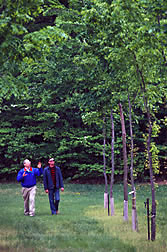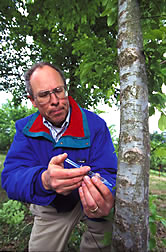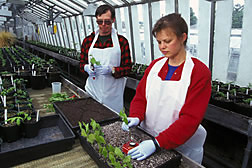New American Elms Restore Stately Trees
|
|
Alden M. Townsend has been on a quest for the last 20 years—a quest to find and develop disease-tolerant American elms and return these prized trees to U.S. towns, yards, and landscapes.
"American elms have been the nation's main urban landscape tree," says Townsend. "Just about every city and town has an Elm Street. American elms were planted everywhere until the early 1940's, when Dutch elm disease spread rapidly."
Townsend is an Agricultural Research Service plant geneticist at the U.S. National Arboretum's Glenn Dale, Maryland, laboratory. He says that USDA scientists began screening elm trees for Dutch elm disease (DED) tolerance in 1937.
Shipments of elm tree logs from France to Cleveland, Ohio, accidentally introduced the fungus into the United States in 1931. Within 4 to 5 years, scientists could trace the logs' trip inland by looking at elm trees along the railroad route. The death trail ran all the way to furniture manufacturers in Cleveland and Columbus, where the imported elms were used for making veneer.
By 1980, Ophiostoma ulmi—the fungus that causes Dutch elm disease—had virtually wiped out 77 million American elms. The loss of those prized shade trees denuded hundreds of tree-lined streets in towns and cities across the country.
Leaves on a DED-infected tree first turn yellow, then brown, as wilting symptoms gradually move up branches to the main trunk. The next year, dieback is very noticeable. And in just a short time—often by the second year—the disease becomes fatal.
Townsend says, “The loss of these American elms has not been just economic. Their loss was also psychological, with a negative effect on people’s psyches.”
American elms have been prized for their graceful stature and other aesthetic attributes. But their superior adaptability, inherent vigor, hardiness, and tolerance to stresses—especially in urban settings—are unsurpassed in comparison with most tree species. “Trees planted on city streets take a lot of abuse,” says Townsend. “Landscape trees like maple, ash, and oak aren’t nearly as adaptable as the American elm in withstanding such adverse environmental conditions.”
|
|
Finding Pockets of Resistance
Dutch elm disease was first found in the Netherlands. “But, ironically,” says Townsend, “the American elm, Ulmus americana, is the elm species most susceptible to the European disease. Its fast spread was probably due to the trees’ overuse here, since they were easy to plant and grow.”
About 20 years ago, Townsend and plant pathologist Lawrence R. Schreiber (now retired), along with ARS technician Warren O. Masters, started screening thousands of American elms, searching for DED-tolerant specimens to propagate at the arboretum’s research site at Delaware, Ohio. Masters is now in the ARS Root Disease and Biological Control Research Unit at Pullman, Washington.
“We would get numerous cuttings from people who believed they had an ancient survivor growing in their yard,” says Schreiber. “But we soon discovered that most of those trees were just lucky. They had simply not been attacked by the elm bark beetle that spreads the disease.”
Adds Townsend, “It is not uncommon to find a single elm surviving by chance where others have died.”
He estimates that only 1 in 100,000 American elm trees is DED-tolerant. “Most of the thousands we tested turned out simply to have escaped exposure.”
The procedure the scientists used to find and screen trees for built-in DED tolerance is exacting.
When a survivor tree is selected for study, fresh shoots are cut from as near the top as possible. Back in the greenhouse, the shoots are rooted using a growth hormone. Those that take root and grow are deliberately inoculated with the DED fungus to see which naturally resist the disease.
Recently, Townsend introduced two new American elms—Valley Forge and New Harmony. They represent a culmination of work he and Schreiber, along with several other colleagues, have done over more than 20 years. “These will be the first commercially available new DED-tolerant American elm trees,” Townsend says.
Last year, several hundred rooted cuttings of Valley Forge and a few New Harmony were officially released—or introduced—to nurseries, experiment stations, and arboretums. Wholesale nurseries will propagate the trees for sale by late 1997 or 1998; retail nurseries should have them in 1999.
Townsend says the new cultivars are easy to propagate by softwood cuttings using conventional propagation techniques. Rooting generally occurs in less than 4 weeks.
They are products of the arboretum's tree genetics program. This research is directed toward developing improved tree cultivars with superior characteristics for nursery production and for urban, suburban, and rural use, says ARS botanist Thomas S. Elias, director of the arboretum. ARS moved the elm program there from Ohio in 1984 but retained established planting material at the Ohio location.
Elias says, "The disease tolerance and superior horticultural characteristics of these two new cultivars make them ideal candidates to replace the millions of trees that have died as a result of Dutch elm disease." On June 6, 1996, one of them was planted on the grounds of the U.S. Capitol in Washington, D.C.
Making a Commercial Comeback
Interest in restoring American elms is evident in several grass-roots movements.
Since 1993, Cincinnati businessman Bill Monroe has made elm research part of his business interest. Monroe's passion for restoring American elms has him networking nationally with fellow enthusiasts—federal, state, city, and local. He has spoken extensively with over 20 scientists, including Townsend, all of whom are specialists in various aspects of elm research.
Monroe says that when it comes to developing new American elms with DED tolerance, the U.S. National Arboretum and USDA’s Forest Service Forestry Sciences Laboratory at Delaware, Ohio, are the key research locations in this country.
For the last 3 years, Townsend and Masters have been collaborating with Forest Service biologists Joseph Kamalay and Steve Eshita at the Ohio lab. All four have worked together to make controlled genetic crosses with the two new American elms and several other American elm selections. About 500 seedlings from these crosses have been planted for future evaluation.
Kamalay has been using DNA fingerprinting to search for DED-tolerance markers in the new elms. He says, "We are looking for a better, faster way to screen for tolerance."
According to Townsend, "Monroe has done a lot of good for elm tree restoration by getting the word out about the two new cultivars. He helped start the Cincinnati DED-tolerant American elm program. It's the first and only DED-tolerant American elm nursery and marketing program under professional management in a major metropolitan area."
The Cincinnati program involves a commercial tree nursery, the city's urban forestry department, and several hundred garden club members who plan to plant the new American elms in and around the city. Monroe says that pivotal in their program is the work of Richard Ammon of Ammon Nurseries in Burlington, Kentucky, who is raising and propagating the new elms for the program.
Interest in the new American elms is shared by Roy Klehm of Klehm Nursery in South Barrington, Illinois, whose nursery is 1 of 17 propagating Valley Forge, New Harmony, and other elm hybrids previously released by the arboretum.
Klehm says, "Chicagoans are in love with them, and the city foresters are asking for large numbers for park and street planting."
While at the Ohio lab, Townsend worked with Masters and Schreiber in carrying out intensive disease inoculations of scores of American elms. Later, at the arboretum's Floral and Nursery Plant Research Unit's Glenn Dale lab, Townsend continued that work with ARS horticulturist Susan E. Bentz and arboretum gardener Tom Abell.
|
|
Since 1986, they have screened 10 of the most DED-tolerant American elms for superior tolerance. Valley Forge and New Harmony resulted from this last, intensive effort.
"Compared with other American elm selections and seedlings, these trees showed significantly lower foliar symptoms and crown dieback after being intensively inoculated with the fungus," Townsend says.
Although neither Valley Forge nor New Harmony is completely immune to the Dutch elm disease, both have unusually high levels of tolerance.
Of the thousands of American elms that have been screened, Valley Forge is the most tolerant, and New Harmony is a close runner-up. An unnamed third—at least as tolerant as New Harmony—may become the third introduction to be released by the arboretum, after further testing.
Townsend has also worked cooperatively with Richard Hall of Ohio State University screening elms for elm leaf beetle tolerance. More recently, he has supplied leaves of Valley Forge trees to ARS plant pathologist Ing-Ming Lee at the Molecular Plant Pathology Laboratory in Beltsville, Maryland.
Lee screened the leaves for the presence of elm yellows, a disease caused by a phytoplasma—a tiny bacterium-like organism. Lee has developed a new tool to detect the minute organism. The test uses polymerase chain reaction, or PCR, to identify the presence of the phytoplasma organism, to determine if the tree is infected.
Since an outbreak of elm yellows disease occurred in the Delaware, Ohio, site while the new American elms were being tested, Townsend believes there is a possibility the new elms may also have some tolerance to elm yellows. None of the Valley Forge and New Harmony trees showed the disease, while about 15 percent of other American elms acquired it. However, further testing will be needed to confirm this apparent tolerance.
Both of the new cultivars have the classic elm shape that made their predecessors so desirable as shade trees. Valley Forge has an upright, arching, broadly V-shaped branching structure with a full, dense canopy of leaves. After 12 growing seasons in Ohio, cuttings from the parent tree are 26 feet tall, with an average crown spread of 30 feet. Leaves 4.6 inches long and 2.9 inches wide gradually turn yellow in autumn. The bark divides into grayish, rough-textured ridges separated by diamond-shaped fissures that are typical of elm species.
New Harmony has a broadly V-shaped crown with the main trunk dividing nearly 30 feet from the ground into several erect limbs that are strongly arched and terminate in numerous slender, often drooping branches. New Harmony's parent tree is 68 feet tall with an average crown spread of 72 feet. Its leaves are 4.2 inches long and 2.5 inches wide and turn yellow in autumn.
In adaptability tests, Valley Forge has performed well in Ohio, Maryland, and the District of Columbia and can be considered adaptable in plant hardiness zones 5 through 7. New Harmony has grown well in Georgia, Maryland, Minnesota, New Jersey, Ohio, Oklahoma, Pennsylvania, and Tennessee. It is also adaptable in zones 5 to 7, with possible cold hardiness into zone 4.—By Hank Becker, ARS.
USDA-ARS U.S. National Arboretum
Congress Honors Arboretum
The many research accomplishments of the U.S. National Arboretum were acknowledged at a tree-planting ceremony held in Washington, D.C., on June 6,1996. Installed on the grounds of the U.S. National Capitol at that time was a disease-tolerant Valley Forge American elm developed by arboretum plant geneticist Alden M. Townsend.
Congressional recognition of the arboretum's nearly 70-year contribution to horticultural science was initiated by Missouri Senator Christopher S. Bond. He joined arboretum director Thomas S. Elias and members of the Friends of the National Arboretum at the planting ceremony.
Arboretum Releases Elm Hybrids
Besides Valley Forge and New Harmony, geneticist Alden M. Townsend has introduced—or officially released to nurseries for propagation—seven other new elm trees. They were selected and bred from Asian and European species that normally resist the Dutch elm disease (DED) fungus. An eighth has been introduced by ARS geneticist Frank S. Santamour, Jr., who is Townsend's colleague at the U.S. National Arboretum.
All eight elms were released over the past 12 years as part of the arboretum's plant introduction program. Developed to provide superior trees for city conditions, they require less maintenance, have higher survival rates, and need less pesticide than most other trees.
- Prospector originated from selected seedlings of the Wilson elm from China. It has a V-shaped crown like the American elm but is shorter and resistant to Dutch elm disease and the elm leaf beetle.
- Frontier was developed by crossing the lacebark elm, Ulmus parvifolia, with a European species. It has a pyramidal crown, with moderate resistance to the beetle and good DED resistance.
- Homestead is a cross between a Siberian elm and a complex hybrid of two Dutch elms. A rapid grower, it has a pyramidal crown, high level of DED resistance, and excellent tolerance to environmental stresses.
- Pioneer is a globe-shaped hybrid cross between two European species. It is quite DED-resistant but, like Homestead, has some susceptibility to the elm leaf beetle. Its crown is dense and provides deep shade.
- Patriot is a cross between Prospector and Urban elms. Its moderately V-shaped crown resembles that of a more upright American elm. It is highly resistant to disease and resists insect infestations.
- Ohio is a lacebark elm selection that is moderately V-shaped, with excellent resistance to the elm leaf beetle and Dutch elm disease.
- Pathfinder is a lacebark elm with a single trunk and has both high insect and disease resistance.
- Dynasty is a lacebark elm of Korean parentage that was released by Santamour because of its smaller stature and potential use under power lines along city streets. — By Hank Becker, ARS.
"New American Elms Restore Stately Trees" was published in the July 1996 issue of Agricultural Research magazine.










